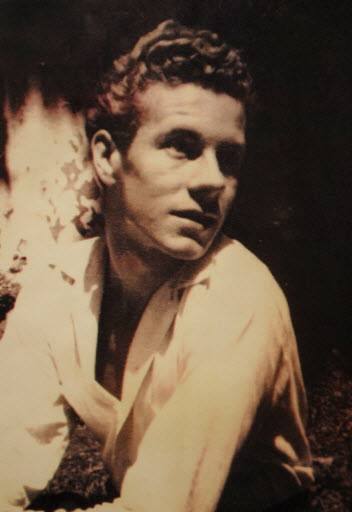

Husband Cris Alexander
Queer Places:
35 Greenfield Ave, Saratoga Springs, NY 12866
 Shaun O’Brien (November 28, 1925 - February 23, 2012)
was one of the country's most celebrated character dancers, whose four vigorous decades with the New York City Ballet
included more than 30 holiday seasons as Herr Drosselmeyer, the kindly
eccentric at the heart of "The Nutcracker."
Shaun O’Brien (November 28, 1925 - February 23, 2012)
was one of the country's most celebrated character dancers, whose four vigorous decades with the New York City Ballet
included more than 30 holiday seasons as Herr Drosselmeyer, the kindly
eccentric at the heart of "The Nutcracker."
City Ballet was founded by George Balanchine and Lincoln Kirstein in 1948, and O'Brien joined the company the next year as a member of the corps. By the time he retired, in 1991 at the age of 65, he had appeared alongside a Who's Who of dancers of the entire mid-20th century, including Violette Verdy, Allegra Kent, Patricia McBride, Jerome Robbins, Edward Villella and Jacques d'Amboise.
He owed this longevity, remarkable in ballet, to his having slipped early on " unintentionally but quite happily " into character roles. Few dancers seek such parts, which tend toward grizzled sorcerers rather than dashing princes, but O'Brien, in the opinion of balletgoers and many critics, invested them with a wordless emotional resonance rarely before seen.
And though he would never dance a pas de deux with the prima ballerina, his calling, with its attendant lack of wear on the body, gave him something a dancer can rarely expect: steady employment with a major company for 42 years, and perennial standing as an audience favorite for nearly all that time.
Though he had no formal dramatic training, O'Brien was considered one of the finest acting dancers on the ballet stage, relying on a swift, subtle confederacy of face, hands and feet that would rival a mime's but were still every inch a dancer's.
O'Brien, who is informally believed to hold at least the American record for career Drosselmeyers, became so invested in the role " the character is the elderly toymaker whose gift of a nutcracker doll sets the story in motion " that he had difficulty turning it off.
"I was really getting quite daffy," he told The New York Times in 1987, recalling a period of several seasons during which he danced the part at every one of City Ballet's performances. "I found myself walking around nodding my finger at people."
He was equally celebrated as Dr. Coppelius, the obsessed, tragic dollmaker at the center of Balanchine's "Coppelia." O'Brien originated the role in 1974 and performed it for years afterward " including at his farewell performance, on Feb. 8, 1991.
"You can always get a rise out of audiences with technique," he told The Times in a 1975 interview. "But if you can coax them into becoming emotionally involved, there's real appreciation. Every time we do "˜Coppelia,' I'm amazed by their reaction. They're not thinking, "˜Oh, that's Shaun O'Brien whom we must clap for because he is so famous.' They're really clapping for Coppelius."
John Peter O'Brien was born on Nov. 28, 1925, in Brooklyn and reared in the Bay Ridge neighborhood there. (He changed his name to Shaun early in his career.) He made his dance debut at 4 beside his older sister in a local recital, a longer event than its organizers intended.
"I loved every minute of it," he recalled in a 1979 interview with The Times. "They had to get out the hook and lower the curtain, because I refused to leave the stage."
As a teenager, he resolved to dance professionally. "My parents were not overjoyed," he said in the same interview. "They wanted me to choose something more suitable, more sensible."
As a youth, he studied in Manhattan at the School of American Ballet and in the mid-1940s danced in several Broadway musicals, including "Polonaise" and "Sleepy Hollow." He later performed with companies led by the Marquis de Cuevas, Serge Lifar and Alicia Alonso before joining City Ballet.
His other notable roles with the company in Balanchine works include the upright Father in "Prodigal Son," rooted in the Gospel According to St. Luke, and the sinister Baron in "La Sonnambula," based on melodies from Bellini operas.
O'Brien was the original Leandre in "Harlequinade," Balanchine's 1965 ballet inspired by commedia dell'arte, a role he danced many times afterward.
Reviewing his Leandre in The Times in 1966, Clive Barnes called Mr. O'Brien "awkward, horrid and totally undeserving" " all fine things indeed " "as Columbine's understandably rejected suitor."
O'Brien, who lived in Saratoga Springs, is survived by Cris Alexander, an actor, dancer and photographer and his companion of 61 years, whom he married in New York State after same-sex marriage was legalized there.
For all the glowing notices O'Brien received, and all the roses, one accolade in particular was " in its way " a highlight of his career. It came in 1957, after O'Brien danced his first significant character role at City Ballet, that of the mother in a revival of Lew Christensen's comic work "Filling Station."
The character, in O'Brien's words a "dreadful old dreadnought," was originally written for a woman. In this production she was danced by O'Brien, got up to look like a woman.
In the audience that night, was O'Brien's actual mother, overjoyed.
"Everyone," she told her son afterward, flush with pride, "said you looked like me."
He died in Saratoga Springs, N.Y. He was 86 and had been retired from the company for merely 21 years. His death, of natural causes, was confirmed by the William J. Burke & Sons Funeral Home in Saratoga Springs.
My published books: